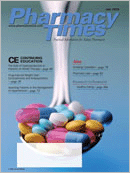Publication
Article
Pharmacy Times
Assisting Patients in the Management of Hypertension
Educating patients about the importance of consistent and thorough management of hypertension is a fundamental step in controlling this condition that affects nearly 1 in 3 adults in the United States, or ~65 million individuals.1 In addition, the results of the PREMIER study, which appeared in the April 4, 2006, issue of Annals of Internal Medicine, show that an additional 59 million adults are considered to have prehypertension?a condition that may increase their risk of cardiovascular and cerebrovascular disease1,2 (Table 1). The study demonstrated that implementing healthy lifestyle changes can produce positive results in controlling blood pressure. Research also indicates that approximately one third of teens in the United States are at an increased risk of developing hypertension, as well as other cardiovascular complications, because of low rates of cardiorespiratory fitness.3,4
Recently, the American Society of Health-System Pharmacists encouraged all health care systems to develop measures that will assist in identifying and treating those with hypertension and assist this patient population in achieving the best possible control of their blood pressure.5 Working in conjunction with other health care providers, pharmacists can positively impact the quality of care for patients with hypertension. In addition to evaluating drug therapy and making clinical recommendations that may enhance therapeutic outcomes and increase patient compliance, pharmacists can identify possible drug interactions and contraindications and minimize the incidence of adverse effects.
Counseling Patients About Treating Hypertension
When counseling patients who have hypertension, it is imperative that pharmacists stress the importance of adhering to the treatment plan chosen for the individual by the primary health care provider. The pharmacist also should remind patients that the overall goal of hypertension treatment is to lower blood pressure. In so doing, patients can decrease the incidence of long-term complications, including atherosclerosis, stroke, heart failure, hypertension-related kidney disease, and hypertensive retinopathy.
More than 50% of patients who have been placed on antihypertensive agents discontinue their therapy within 12 months for one or more of the following reasons6:
- Adverse effects associated with the medications
- Limited knowledge about the disease and its treatments
- Cost of medications and of access to health care providers
Because the treatment of hypertension involves a multistep plan, pharmacists should make certain that patients clearly understand the required lifestyle modifications as well as the importance of adhering to the instructions regarding taking prescribed pharmacologic agents. Furthermore, for those patients who are started on a pharmacologic therapy regimen, it is crucial that pharmacists ensure that patients thoroughly understand the importance of compliance, including proper administration, dosage, and potential adverse effects associated with the agents prescribed for them.
Initially, some patients may be adequately controlled by the use of a single agent, whereas the majority of patients will require the use of multiple antihypertensive agents. The Seventh Report of the Joint National Committee on Prevention, Detection, Evaluation, and Treatment of High Blood Pressure (JNC 7) recommends that the selection of therapy be dependent on the stage of the hypertension, as well as the presence of comorbid conditions, such as heart failure, chronic kidney disease, or diabetes. For patient populations with stage 1 hypertension without compelling indications, thiazide diuretics are typically used. In patients with stage 2 hypertension without compelling indications, the use of a thiazide diuretic in combination with an angiotensin-converting enzyme inhibitor, angiotensin receptor blocker, beta-blocker, or calcium channel blocker is recommended.7 The JNC 7 report also recommends a combination of specific classes of antihypertensive agents for patients with compelling indications (Table 2).
Patients should be reminded to discuss any concerns about therapy with their physician and never to abruptly discontinue any medication unless directed to by their physician.
In addition to providing thorough medication counseling, pharmacists can assist in the management of hypertension by reinforcing the importance of incorporating nonpharmacologic interventions to further assist in controlling blood pressure. Patients should be reminded that certain lifestyle factors may cause elevated blood pressure, such as a sedentary lifestyle, smoking, stress, and diets high in sodium (Table 3). Medical conditions and the use of certain pharmacologic agents also may contribute to elevated blood pressure.7
Use of At-home Blood Pressure Monitors
Research has shown that patients who conduct self-monitoring of their blood pressure at home as well as having consistent follow-ups with their physicians tend to show better overall control of their hypertension.8,9 Pharmacists can assist patients in making the appropriate selection of a home blood pressure monitoring system that is best suited for them, as well as providing instructions on the appropriate use of these monitors (Tables 4 and 5).
Conclusion
In addition to monitoring an individual's medication profile, pharmacists can be an essential resource for patients for obtaining information about hypertension and for reinforcing the treatment goals established by the patient's physician. Pharmacist interventions can significantly improve outcomes and increase patient compliance and the overall quality of care for many patients.
For more information on hypertension, please visit the following Web sites:
- American Society of Hypertension: www.ash-us.org
- National Institutes of Health: www.nih.gov
- American Heart Association: www.americanheart.org
- National Heart, Lung, and Blood Institute: www.nhlbi.nih.gov
Ms. Terrie is a clinical pharmacy writer based in Haymarket,Va.
For a list of references, send a stamped, self-addressed envelope to: References Department, Attn. A. Stahl, Pharmacy Times, 241 Forsgate Drive, Jamesburg, NJ 08831; or send an e-mail request to: astahl@ascendmedia.com.







